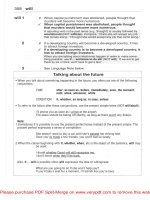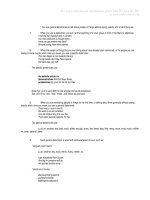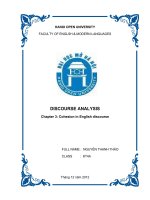Demonstrated english 3 pdf
Bạn đang xem bản rút gọn của tài liệu. Xem và tải ngay bản đầy đủ của tài liệu tại đây (75.68 KB, 6 trang )
4. Although more than 95% of earthquakes occur
in plate marg
ins (meaning areas in which plates
separate, grind past each other, or collide), New
York State has experienced over 400 earthquakes
in the past two centuries and it is not near any
plate margins.
a. margins (meaning areas in which plates sepa-
rate, grind past each other, or collide),
b. margins, which are simply areas in which
plates separate, or they might grind past each
other, or they could collide,
c. margins (“margins” here refers to areas in
which plates separate, grind past each other,
or collide),
d. margins (meaning those areas in which plates
of the earth’s crust separate, grind past each
other, or collide),
e. margins. Margins are areas in which plates
separate, grind past each other, or collide.
5. A
ccording to the Barbecue Industry Association,
three out of four U.S. households own a barbe-
cue grill, more than half of all Americans use
their grills year-round, and over 60% of barbe-
cuers wer
e men.
a. According to the Barbecue Industry Associa-
tion, three out of four U.S. households own a
barbecue grill, more than half of all Ameri-
cans use their grills year-round, and over 60%
of barbecuers were men.
b. According to the Barbecue Industry Associa-
tion, there are three out of four U.S. house-
holds that own a barbecue grill, more than
half of all Americans use their grills year-
round, and over 60% of barbecuers were men.
c. According to the Barbecue Industry Associa-
tion, there are three out of four U.S. house-
holds that own a barbecue grill, more than
half of all Americans use their grills year-
round, and over 60% of barbecuers are men.
d. The Barbecue Industry Association reports
that three out of four U.S. households own a
barbecue grill, more than half of all Ameri-
cans use their grills year-round, and over 60%
of barbecuers were men.
e. According to the Barbecue Industry Associa-
tion, three out of four U.S. households own a
barbecue grill, more than half of all Ameri-
cans use their grills year-round, and over 60%
of barbecuers are men.
–PRACTICE TEST 3–
150
6. Jealousy is often defined as the desire to keep
something (or someone) that one already has,
while envy is the desire to obtain something that
so
meone else has.
a. has, while envy is the desire to obtain some-
thing that someone else has.
b. has, so that envy is the desire to obtain some-
thing that someone else has.
c. has, while envy is when you desire to obtain
something that someone else has.
d. has, and envy is about the desire to obtain
something that someone else has.
e. has, because envy is the desire to obtain some-
thing that someone else has.
7. Paprika, a powdered form of dried red peppers
and mainstay of Hungarian cuisine, became
c
ommonly used in the 19th century and is avail-
ab
le in varieties ranging from mild to hot.
a. commonly used in the 19th century and is
available in varieties ranging from mild to hot.
b. available in varieties ranging from mild to hot
after it became commonly used in the 19th
century.
c. commonly used in the 19th century. Since
then, it has become available in varieties rang-
ing from mild to hot.
d. commonly used in the 19th century; it then
became available in varieties ranging from
mild to hot.
e. commonly used in the 19th century, when it
was available in varieties ranging from mild
to hot.
8. If you’ve heard that shamp
oo can cause cancer,
bananas may contain a flesh-eating bacteria, or
that you could unlock your car door with a cell
p
hone, you’ve read an Internet hoax.
a. shampoo can cause cancer, bananas may con-
tain a flesh-eating bacteria, or that you could
unlock your car door with a cell phone,
b. shampoo can cause cancer, you can find flesh-
eating bacteria in bananas, or that you could
unlock your car door with a cell phone,
c. cancer can be caused by shampoo, bananas
may contain a flesh-eating bacteria, or that
you could unlock your car door with a cell
phone,
d. shampoo can cause cancer, bananas may con-
tain a flesh-eating bacteria, or that you could
use your cell phone to unlock your car door,
e. shampoo can cause cancer, bananas may con-
tain a flesh-eating bacteria, or that cell phones
can unlock car doors,
9. The Fédération Internationale de Gymnastique
(FIG) began as a group of representatives of the
gymnastics associations of Belgium, France, and
the Netherlands in 1881,
so now includes coun-
t
ries from around the world.
a. in 1881, so now includes countries from
around the world.
b. in 1881, but now include countries from
around the world.
c. in 1881; now include countries from around
the world.
d. in 1881, then later it would include countries
from around the world.
e. in 1881, but now includes countries from
around the world.
–PRACTICE TEST 3–
151
10. You can participate in a massive recycling effort
just by purchasing carpeting made of polyester
rather than nylon fi
bers, which is made from
recycled plastic bottles.
a. fibers, which is made from recycled plastic
bottles.
b. fibers. These fibers are made from recycled
plastic bottles.
c. fibers. They are made from recycled plastic
bottles.
d. fibers, which are made from plastic bottles
that have been recycled.
e. fibers, which makes carpeting out of recycled
plastic bottles.
11. One of the longest bridges in the world, the
A
merican Society of Civil Engineers named San
F
rancisco’s Golden Gate Bridge, completed in
1937,
a “Mo
nument of the Millennium.”
a. the American Society of Civil Engineers
named San Francisco’s Golden Gate Bridge,
completed in 1937, a “Monument of the Mil-
lennium.”
b. the American Society of Civil Engineers, com-
pleted in 1937, named the Golden Gate Bridge
of San Francisco, a “Monument of the Millen-
nium.”
c. San Francisco’s Golden Gate Bridge, a “Monu-
ment of the Millennium,” was completed in
1937 by the American Society of Civil
Engineers.
d. the Golden Gate Bridge in San Francisco was
completed in 1937 and was named a “Monu-
ment of the Millennium” by the American
Society of Civil Engineers.
e. the American Society of Civil Engineers
named the 1937 San Francisco bridge the
Golden Gate a “Monument of the Millenium.”
12. Insect pests of farm crops are difficult to control
when necessary activities such as t
illage; weeding;
irrigation; and harvesting increase the pest popu-
lation and decrease the numbers of its natural
enemies.
a. tillage; weeding; irrigation; and harvesting
increase the pest population and decrease the
numbers of its natural enemies.
b. tillage; weeding; irrigation; and harvesting
increase the pest population and decrease the
numbers of their natural enemies.
c. tillage, weeding, irrigation, and harvesting
increase the pest population and decrease the
numbers of their natural enemies.
d. tillage, weeding, irrigation, and harvesting
increase the pest population and decrease the
numbers of its natural enemies.
e. tillage, weeding, irrigation, and harvesting
increase the pest population and decrease the
number of its natural enemy.
13. Gertrude Stein coined the phrase “the Lost Gen-
eration” to describe a group of A
merican expatri-
at
e writ
ers living in Paris in the 1920’s and 30’s,
inc
luding Ernest Hemingway, F. Scott Fitzgerald,
and Sherwood Anderson.
a. American expatriate writers living in Paris in
the 1920’s and 30’s, including
b. American expatriot writers living in Paris in
the 1920’s and 30’s, including
c. American expatriate writers living in Paris in
the 1920s and 30s, including
d. American expatriate writers living in Paris in
the 1920s and 30s and who included
e. American expatriot writers living in Paris in
the 1920s and 30s, including
–PRACTICE TEST 3–
152
14. Anton Bruckner, considered the Austrian master
of the 19th-century symphony, couldn’t support
himself completely by being a composer, so he
also worked as a church organist, first at St. Flo-
rian in
Ansfelden and then at Linz Cathe
dral.
a. Anton Bruckner, considered the Austrian mas-
ter of the 19th-century symphony, couldn’t
support himself completely by being a com-
poser, so he also worked as a church organist,
first at St. Florian in Ansfelden and then at
Linz Cathedral.
b. Austrian master of the 19th-century sym-
phony, Anton Bruckner supported himself as
a composer by working as a church organist,
first at St. Florian in Ansfelden and then at
Linz Cathedral.
c. As the Austrian master of the 19th-century
symphony, Anton Bruckner was not only a
composer, but also supported himself by
working as a church organist, first at St. Flo-
rian in Ansfelden and then at Linz Cathedral.
d. Austrian master of the 19th-century sym-
phony, Anton Bruckner had to resort to sup-
porting himself as a composer by working as a
church organist, first at St. Florian in Ans-
felden and then later at Linz Cathedral.
e. Indisputably the Austrian master of the 19th-
century symphony, Anton Bruckner couldn’t
completely support himself as a composer, so
he worked as a church organist, first at St. Flo-
rian in Ansfelden and then at Linz Cathedral.
–PRACTICE TEST 3–
153
6
5
4
3
Answer Key
Section 1: Essay
Use the following rubric to evaluate your writing. This
practice essay is included so you can work on time man-
agement and the specific essay-writing strategies you
learned in Chapter 3. It’s also here for you to compare
your finished product with the rubric. The more you
practice and perform these evaluations, the better you’ll
understand exactly what your scorers are looking for.
–PRACTICE TEST 3–
154
■
Demonstrates outstanding writing skills
■
Includes a clear and insightful point of view on the question and reflects excellent critical think-
ing, using strong examples and other evidence to support this point of view
■
Contains a strong organization and focus, a clear sense of unity, and a skillful flow of ideas
■
Demonstrates a strong command of language, with varied and appropriate word choice, and
meaningful variation in sentence structure
■
Contains few, if any, errors in grammar, usage, and mechanics
■
Demonstrates effective writing skills
■
Includes a clear point of view on the question and reflects strong critical thinking, using good
examples and other evidence to support this point of view
■
Contains strong organization and focus, a sense of unity, and a flow of ideas
■
Demonstrates a good command of language, with appropriate word choices and variation in
sentence structure
■
Contains few errors in grammar, usage, and mechanics
■
Demonstrates competent writing skills, but the quality of the writing may be inconsistent
■
Includes a point of view on the question and reflects competent critical thinking, using sufficient
examples to support this point of view
■
Contains a general organizational plan and focus, with some unity and flow of ideas
■
appropriate word choice and some variation in sentence structure
■
Contains some errors in grammar, usage, and mechanics
■
Demonstrates inadequate, but not incompetent, writing skills
■
Includes a point of view on the question, reflecting some critical thinking, but this point of view
may be inconsistent or incomplete, and support may be lacking
■
Contains a limited organizational strategy and focus, with a weak or inconsistent sense of unity
and flow of ideas
■
Demonstrates a developing but weak command of language, with weak or inappropriate vocabu-
lary, little or no variation in sentence structure, and may contain errors in sentence construction
■
Contains many errors in grammar, usage, and mechanics
Here are examples of a couple of essays written on the
assignment:
You might think a memorable picture would have
vivid color, an appealing or inspirational theme, or be
something you might want to display and look at
every day. That is not the case with the picture
that is most memorable to me. Rather, it is a large
mural, painted in 1937 by the Spanish artist, Pablo
Picasso, to protest the bombing of a small village in
northern Spain.
Surprisingly, there is no vivid red color to show
the flowing blood. One must imagine this, for the
mural is startlingly gray, black, and white. But there
is no avoiding the horror of the images. The figures
are not realistically drawn, but are cubist and
abstract, and it is apparent that innocent civilians
are being slaughtered. A mother screams with her
mouth wide open, her head tipped back in heart-
rending anguish, as she holds her dead baby. A sol-
dier lies dead on the ground, clutching his broken
sword, and three other people are shown in shock
and agony. Animals, including a tortured horse and
a crying bird, are also portrayed as innocent victims
of the massacre.
Some symbols are open to interpretation.
What is the meaning of the bull, which seems sim-
ply to be observing, or of the light bulb emitting rays
at the top of the mural? Does the bull symbolize
brute force, and does the light bulb signify that
there is hope? Yet there is no doubt that the dis-
torted, horrible images are intended to shock the
viewer. This depiction of human grief is a profound
statement of the cruelty and senselessness of
war. Limiting the pictures to black and white adds
a funereal element to the shocking depiction of the
catastrophe.
–PRACTICE TEST 3–
155
2
1
0
■
Demonstrates limited writing skills and may contain serious flaws
■
Includes a limited or vague point of view on the question and reflects poor critical thinking,
using inadequate or irrelevant examples or other support
■
Displays a weak sense of organization and/or focus, and may lack unity and/or flow of ideas
■
Demonstrates an inadequate command of language, with limited or incorrect vocabulary, and
incorrect or flawed sentence structure
■
Contains serious errors in grammar, usage, and mechanics that may make the writing difficult to
understand
■
Demonstrates incompetence in writing and contains serious flaws
■
Does not contain a point of view on the question, or provides little or no support for the point
of view
■
Lacks organization and/or focus, unity, and a flow of ideas
■
Contains serious errors in vocabulary and sentence structure
■
Contains serious errors in grammar, usage, and/or mechanics that make the writing difficult to
understand
■
An essay that does not answer the question, or is blank, receives a zero.
(Adapted from The College Board)









